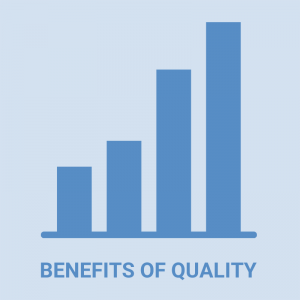Studies show long-term benefits of quality preschool exceed costs

Spending on many state preschool programs is currently quite low; not surprisingly, so are the outcomes. Three of the four states with the largest populations of 3- and 4-year-olds rank near the bottom on quality standards and spending per child. In 2015-2016, average pre-K state spending was $4,976 per child nationwide. In this same year, 32 percent of 4-year-olds and 5 percent of 3-year-olds were served nationally.
Research shows investing in the early years of a child’s life often produces a high rate of return by positively impacting a child’s readiness at kindergarten entry and future success in elementary school, high school, college, and adulthood. Jim Minervino (2014) created a series of research papers that addresses the conditions and costs associated with implementing high quality pre-K. Through his analyses of published research, program evaluations, and “extensive consultation with experts in the early childhood field,” Minervino concluded that there are substantial funds already invested in early learning, however focusing on different practices and policies could yield better results.
James Heckman’s analysis of the Perry Preschool program, the original longitudinal study that proved quality early childhood education has a lasting and positive impact on participants into, found a 7 to 10% return on investment (ROI). A re-analysis of the Perry Preschool Program by Steve Barnett, Director of the National Institute for Early Education Research (NIEER), found benefits rose to $16 for every $1 invested.
Preschool quality is important primarily because children deserve a great experience. In addition, only high-quality programs have been shown to provide long-term benefits to children, families and communities. For children to benefit, investments must be adequate to create and maintain high-quality pre-K classroom experiences.
Suggested Talking Points about Costs vs. Benefits
- Investing in high-quality preschool is a good bet: several studies looking at national, statewide and school districts programs show rates of return between $2 and $4 for every dollar invested in high-quality pre-K.
- A national report on state-funded preschool programs found overall spending increased 8 percent to $7.4 billion in 2015-2016, with spending per child reaching nearly $5,000–exceeding pre-recession levels for the first time.
- Maximizing ROI depends on providing high-quality classroom experiences for children.
- TN preschool program evaluation showed considerable variation, with 7 percent in the “minimal” to “inadequate” quality range and just 15 percent in “good” to “excellent.”
- All children could benefit from high-quality preschool but the need – and the impact — is typically larger for those growing up in poor families.
- ROI results from high-quality program models implemented with attention to high standards—similar to how MPG for a given auto may differ from EPA rating depending on specifics such as road conditions, maintenance and speed
Quotes from National Experts
“Given this return on investment, providing support for early education is more prudent than waiting until high school when issues are often more difficult to remediate.” Brian Bucher, PNC regional President, Alabama School Readiness Alliance’s Pre-K Task Force Members AL.com; June 6, 2016
“Pre-K pays off so well because we pay a high price for failure, particularly in a time when even children from middle-income families have much too high a chance of needing long-term special education or dropping out of school.” W. Steven Barnett, Board of Governor’s Scholar and founder, National Institute of Early Education Research, Rutgers University
“Investing in our children’s early development is an effective way to build the future workforce and customer base we need to be successful.” James Powell, Managing Partner, Nashville Office KPMG (member, ReadyNation)
“Helping parents afford quality early childhood education…is an investment. It increases economic productivity by helping parents work, build careers and income, reduce absenteeism on the job and be a part of a capable and stable workforce.” James J. Heckman, The Henry Schultz Distinguished Service Professor of Economics at the University of Chicago, and a Nobel Memorial Prize winner in economics
Using CPQ Data for State Specific Data
Average spending per child varies by the length of day the child attends a program. This graphic is an example of how to illustrate how per-child spending varies based on part-day; full-day; or extended day pre-K program using the CPQ. To learn how to create similar graphs depicting your specific proposals, please contact CEELO.

CEELO and NIEER Resources about Return on Investment
- Challenges to scaling up effective pre-kindergarten programs. Brookings Institution: The Current State of Scientific Knowledge of Pre-Kindergarten Effects (2017)
- Investments in Young Children Yield High Public Returns (2016)
- Costs, Benefits, and Long-Term Effects of Early Care and Education Programs: Recommendations and Cautions for Community Developments (2006)
- The High/Scope Perry Preschool Program: Cost-Benefit Analysis Using Data from the Age-40 Followup (2006)
- Does It Pay to Invest in Preschool for All? Analyzing Return-on-Investment in Three States (2006)
- Does It Pay to Invest in Preschool for All? Analyzing Return-on-Investment in Three States (2006)
- Comparative benefit–cost analysis of the Abecedarian program and its policy implications (2005)
